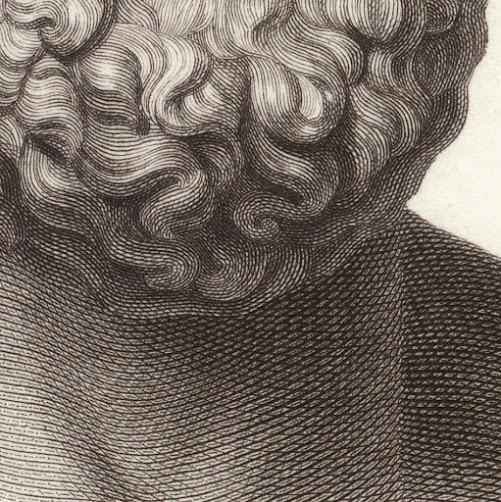William Skelton (1763–1848)
“Marble: Heroic Size” (as titled
on plate), 1809, after the design by Henry A Howard (1769–1847), after a
classical marble bust originally in the collection of the Earl of Egremont,
published in London by Thomas Payne (1719–1799 [note that Payne had
passed away by the date of publication]) and J White (fl.c.1801–1818) for
the Society of Dilettanti (est. 1733) (a society of noblemen and scholars sponsoring the study of ancient Greek
and Roman art) as plate 66 (LXVI) in a series of 133 plates to “Specimens of
Antique Sculptures, Ægyptyan, Etruscan, Greek, and Roman: selected from
different collections in Great Britain” (Jan 1st 1809) and printed
by Thomas Bensley (fl.c.1799–1816). I understand that only 200
impressions were made for the edition.
Regarding the Society of Dilettanti that commissioned this print, I
understand that the vision of the Society (according to what I have gleaned
from Wikipedia) was “to correct and purify the public taste” by exposing the
impressionable to artefacts from the classical world. Although the ambition of
the society may seem a little haughty in its conceit, the outcome is that the
society funded archaeological expeditions, Italian opera and, with the help of
Sir Joshua Reynolds, helped to establish the Royal Academy, as well as
publishing the two-volume book in which this print features. Although the
grand vision and mission of the Society of Dilettanti may not be served very
well by Horace Walpole’s (1743) caustic comment: "...a club, for which the
nominal qualification is having been in Italy, and the real one, [is] being
drunk: the two chiefs are Lord Middlesex and Sir Francis Dashwood, who were
seldom sober the whole time they were in Italy” (Jeremy Black (1985), “The
British and the Grand Tour”, p.120), there were members of the Society that had
a very interesting outlook on art. For example, one of the luminaries of the
Society and a central figure in the publication of this book is Richard Payne
Knight (1750–1824)—an authority on classical art and an active archaeologist.
My understanding of Knight’s vision of art is that he saw paintings and
music—and no doubt this print—as addressing “the organs of sight and
hearing." By contrast, the art of poetry and sculpture appeal
"entirely to the imagination and passions." More interesting with
regard to this print, Knight had the curiously interesting belief that (again,
according to Wikipedia) “artists should seek to reproduce primal visual
sensations, not the mental interpretative processes which give rise to abstract
ideas.” (https://en.wikipedia.org/wiki/Richard_Payne_Knight).
For a marvellous insight into the Society with superb illustrations (but sadly
not this print), see Bruce Redford’s 2008, “Dilenttanti: The Antic and the
Antique in Eighteenth-Century England”, Los Angeles, The J Paul Getty Museum.
Etching and engraving printed
in umber coloured ink on wove paper with wide margins.
Size: (sheet) 42.7 x 31.5 cm;
(plate) 33.2 x 23.5 cm.
Lettered on plate: (lower
left) “H. Howard A. del.”; (lower centre) “MARBLE./ Heroic size./ E. of
EGREMONT./ Published by T. Payne & L. White London, Jan 1st
1809.”; (upper right) “Plate LXVI.”; (lower right) “W. Skelton sc.”
The British Museum offers the
following description of this print:
“Classical marble bust
sculpture of unidentified man, looking up, with severe expression, short curly
hair and beard; after Howard after sculpture then in Earl Egremont's
collection; plate 66 to 'Specimens of Antique Sculptures'
(London: 1809); published state, with open letters. 1809 Engraving with
etching, printed in dark brown ink”
(https://www.britishmuseum.org/collection/object/P_I-12-68; see also https://www.britishmuseum.org/collection/object/P_T-8-107).
Condition: a richly inked, near
faultless impression with wide margins in museum quality/near pristine
condition with no tears, holes, folds, abrasions, significant stains, foxing or
signs of use.
I am selling this technically outstanding
etching exemplifying the English reverence for Classical sculpture as sponsored
by the Society of Dilettanti, for AU$231 (currently US$174.49/EUR143.13/GBP130.13
at the time of this listing) including Express Mail (EMS) postage and handling
to anywhere in the world, but not (of course) any import duties/taxes imposed
by some countries.
If you are interested in
purchasing this stunningly fine etching of the highest order of skill and in a near
pristine condition, please contact me (oz_jim@printsandprinciples.com) and I
will send you a PayPal invoice to make the payment easy.
This print has been sold










No comments:
Post a Comment
Please let me know your thoughts, advice about inaccuracies (including typos) and additional information that you would like to add to any post.